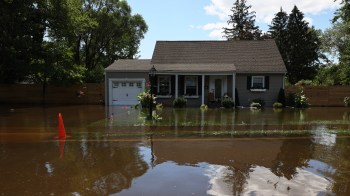There is nothing like a superstorm to make two cellphone competitors play nice-nice. AT&T and T-Mobile say they have temporarily jury-rigged their network in parts of the Northeast so that customers who can’t reach their normal cellphone connection can use the rival’s tower without extra charge.
It is a response to the hurricane, with the FCC’s latest assessment showing more than one in four cell sites remain offline from Virginia through Massachusetts. At a briefing Wednesday, FCC Public Safety & Homeland Security Bureau Chief David Turetsky said regulators are still gathering data on how many telephone landlines are out.
“Because of the flooding, the carriers haven’t been able to assess the damage to their wire line services,” Turetsky said. “So that’s really an ongoing effort.”
When communication towers lie toppled or flooded following a big storm or other disaster, wouldn’t it be nice if somebody could fly in a temporary replacement? Government regulators are working on the idea of doing this using unmanned drones without the weaponry to get disaster communications up and running. A California company, AeroVironment has something that looks very much like a model airplane that launches with a toss of the hand.
Our small unmanned aircraft systems come already equipped with a digital communication technology that basically allows them to operate like mini communications satellites only a few hundred feet above the ground,” says AeroVironment’s Steve Gittin, “they can route voice video and data so emergency communication can be stood up very rapidly after a disasters.”
Bigger drones might some day be able to handle temporary cell phone communication.
As we have been reporting, Twitter and Facebook were useful sources of news for Hurricane Sandy, but also lies. Slate Magazine tech blogger Will Oremus has been keeping track of the bad info on Hurricane Sandy, from a troll spreading a made up report about the stock exchange getting flooded, to more honest mistakes.
“Twitter is this fantastic source of information, ” Oremus says. “Often you will see photos, updates, half an hour or an hour before they appear on any TV news coverage. On the other hand, sometimes there is good reason for that. They may not be accurate.”
At the height of the storm, there were tweets that Coney Island Hospital was on fire. They were not true. Oremus said that one has its root in a report from the police scanner. “Turned out, there was an online version of the police scanner that had been circulating on Twitter,” Oremus says, “So a lot of people were listening in. If you are a news reporter you know that something that comes over a police scanner isn’t necessarily true. They’re going to send out police or firefighters to find out whether it’s true. But I think a lot of people on Twitter who were listening in didn’t necessarily realize that the scanner isn’t always a solid source of information. It turned out later that it was in fact a car fire in the parking lot and the hospital was just fine.”
Anyone who has covered disasters knows rumors always run rife. The internet can amplify that, Oremus agrees. “But as several people have pointed out the internet is also a great checker of facts. And as fast as Twitter spreads misinformation it can debunk misinformation, during Sandy in particular it seemed that misinformation was getting the upper hand,” he says.
There’s a lot happening in the world. Through it all, Marketplace is here for you.
You rely on Marketplace to break down the world’s events and tell you how it affects you in a fact-based, approachable way. We rely on your financial support to keep making that possible.
Your donation today powers the independent journalism that you rely on. For just $5/month, you can help sustain Marketplace so we can keep reporting on the things that matter to you.


















